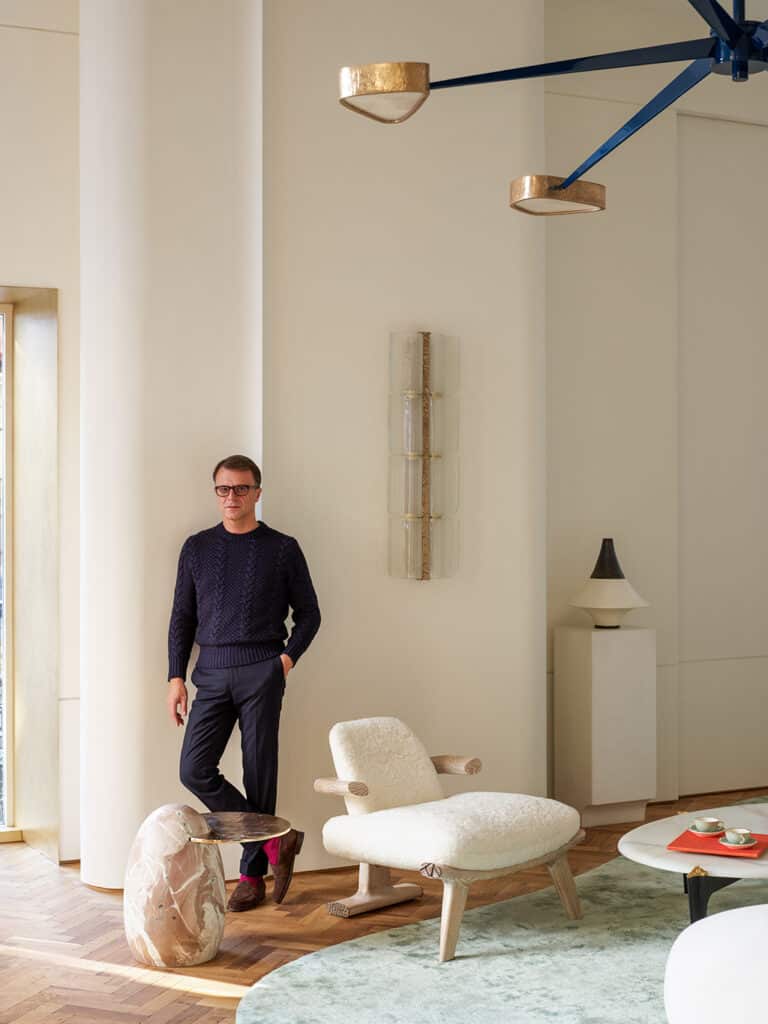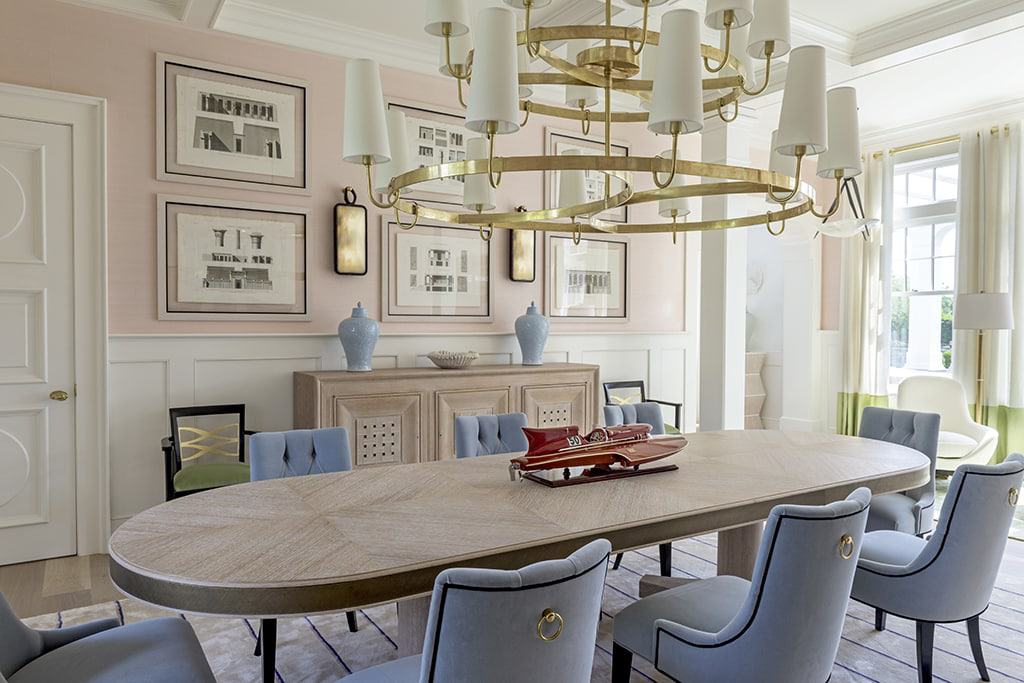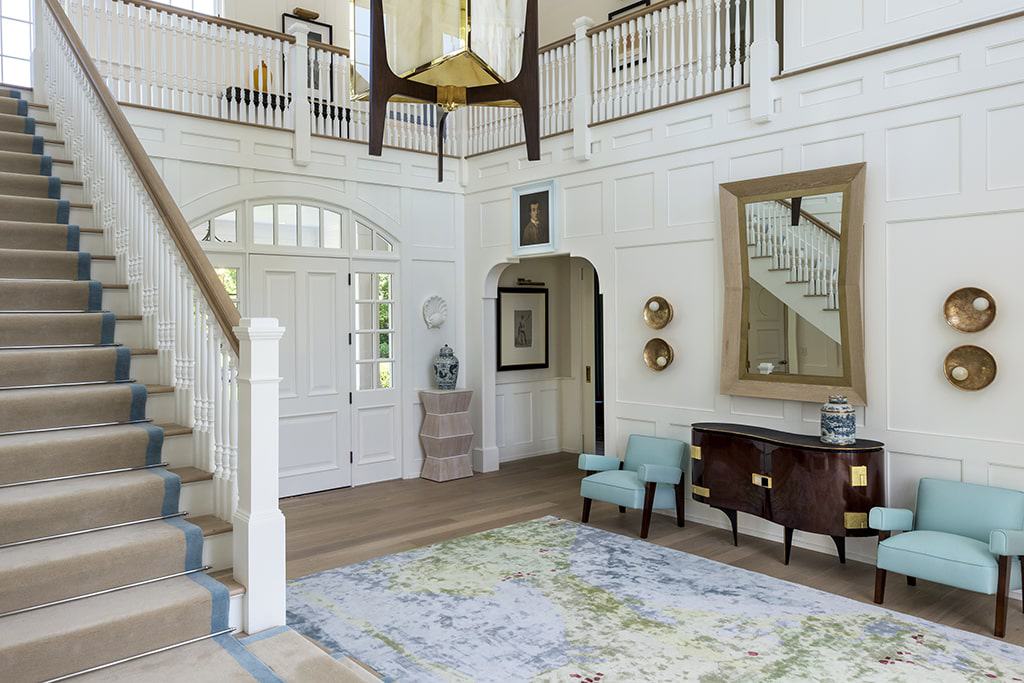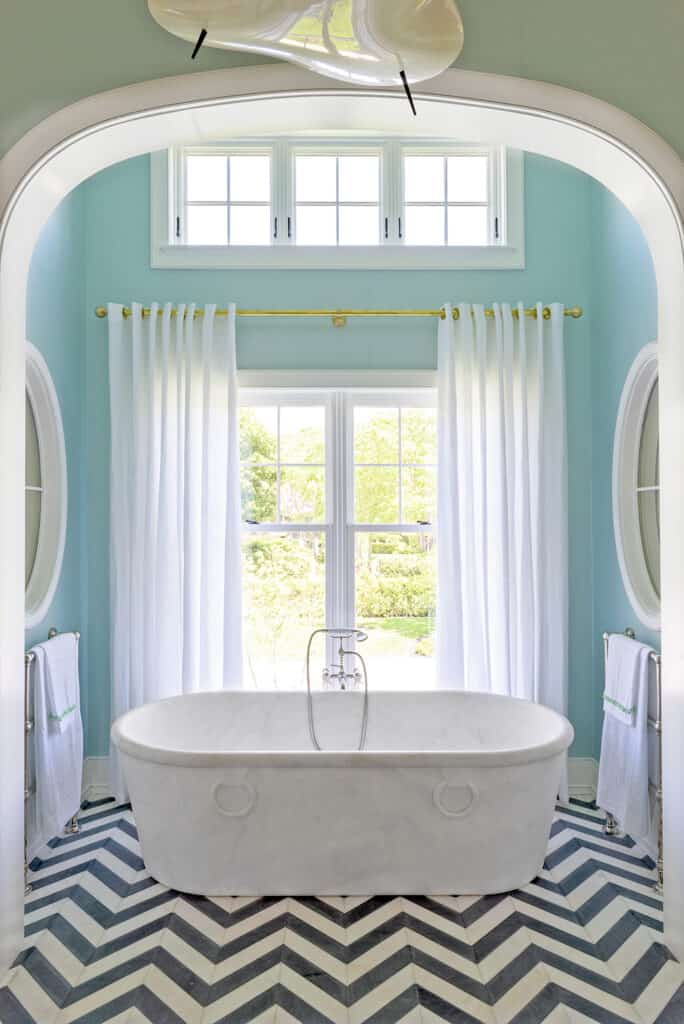The limited-edition furniture in Achille Salvagni’s new London gallery shares design DNA with a project in Southampton.
By Leila Jones
The Italian architect and designer Achille Salvagni, best known for his residential and yacht interiors and bespoke furniture, has moved his eponymous gallery in London’s Mayfair neighborhood to a big new space. With its great arched windows in bronze frames and round-cornered walls ‘wrapped’ in plaster, the venue’s design is every bit as bold as Salvagni’s exquisitely-detailed furniture and sumptuous homeware. At a time when we cannot predict what tomorrow — let alone the next six months — will bring, Salvagni is betting that eternal forms will carry the day.

The appeal is obvious. Current conditions have left of us hungering after design that is soft and textured. We want things of beauty that denote permanence, objects in curvilinear shapes and deep saturated hues. For some collectors and design-followers, Salvagni’s work, with its Italian baroque and Scandinavian modernist underpinnings, satisfies the aesthetic exigencies of our strange new reality.

“I am very much drawn to forms that evoke the sensuousness of a human body, a woman, a belly, to shapes that are organic rather than constructed,” says Salvagni, speaking from London. “Curves, rounded forms, the poetics of softness exemplified by the work of Alvar Alto and other Scandinavian architects and designers, is a means of engaging the natural world in a dialogue.”
But it’s the oneiric, richly allusive quality of his work that makes Salvagni unique. Consider his sensuously-curved ‘Hera’ cabinet. Covered in pomegranate-red parchment, the piece was inspired by the goddess of ancient myth with whom the fruit, a symbol of prosperity, is associated. Yet the pomegranate invariably brings to mind another myth, the one about an eternity of seasons in the underworld. From this perspective, the piece seems an objective correlative of the general mood.

The pandemic has been a gut punch to Italy, which has been harder hit by the pandemic than anywhere in Europe, and its government has made appeals to its neighbors to support both the country and the upholders of its cultural patrimony. Salvagni, who does astonishing things with sumptuous materials like twenty-four carat gold leaf, bronze, royal oak, and onyx, entrusts the execution of his designs to a select group of stone carvers, cabinetmakers, Murano glass-blowers, embroiderers (whose faces he has never seen for they are cloistered nuns), and a bronze caster who is held in high regard at the Vatican.
Given Salvagni’s distinctly European sensibility, you might be surprised to learn that in 2016 he designed the interiors of a quintessentially American compound on two acres in Southampton. The nine-bedroom, 14,000-square-foot mansion was built by Frances Fleetwood, whose ornate country houses are among the defining architectural structures of eastern Long Island.

Salvagni decided that the home’s interiors would evoke the glamour of the Amalfi Coast in the ‘50s and ‘60s, viewed through the double prism of the Hamptons and the designer’s sui generis aesthetic. (The Amalfi theme issued from the homeowner’s personal history.) The challenge was to do so in a way that complemented the interior architecture, which combined Gilded Age references and contemporary flourishes. In a feat of imagination, Salvagni designed furniture and sourced signed vintage pieces that seem at home somehow in the existing structure. His man who is in tight at the Vatican made fifty different bronze casts of the doorhandles in the shape of local fishes, birds, and seashells.

From the spidery bronze, onyx, and 24-carat-gold chandelier and the white rounded sofas in the living room to a sinuous cabinet in the entry hall, the pieces in the Southampton house share the same design DNA as the new works on view at the Mayfair gallery. If the second is the fullest expression of Salvagni’s talent, the first in hindsight was a thrilling preview of things to come.









![Welcome to 114 Seafield Lane, situated on a corner lot and a full private acre with a deeded right of way to Quantuck Bay. This home is made for entertaining with an open kitchen that features 2 oversized islands, pantry and wet bar, library, and a spacious living room with fireplace that overlooks the grounds with an all weather porch perfect for all year enjoyment. Represented by @colleen_graning of @douglaselliman. [link in bio]](https://hamptonsrealestateshowcase.com/wp-content/uploads/sb-instagram-feed-images/472043326_18483682018030135_4434556661967553414_nfull.webp)
![Get ready to stir, shake, or sip as you plan an at-home holiday cocktail party! Whether you prefer bubbly or sophisticated cocktails, here are some chic accessories for a celebratory evening 🍾🥂 [link in bio]](https://hamptonsrealestateshowcase.com/wp-content/uploads/sb-instagram-feed-images/470932215_901131885558340_915943174166158286_nfull.webp)
![Ring in the New Year at @calissahamptons, where the Hamptons meets unparalleled celebration 🥂 Indulge in Mediterranean elegance, sip bubbly under the twinkle of chandeliers, and toast to 2025 with effortless style. This is the NYE party you won’t want to miss! [link in bio]](https://hamptonsrealestateshowcase.com/wp-content/uploads/sb-instagram-feed-images/471814094_670589388645280_7484117556192154580_nfull.webp)
![Start the new year in paradise! Turks & Caicos is calling, with its soft white sandy beaches, crystal-clear waters, and vibrant marine life. Stay at the luxurious @bluehaventci, an all-inclusive escape featuring spacious suites, three bars, two restaurants, a spa, and access to snorkel gear, kayaks, and paddleboards. [link in bio]](https://hamptonsrealestateshowcase.com/wp-content/uploads/sb-instagram-feed-images/470951710_945855790801898_1170969032322633874_nfull.webp)
![Fall in love with this spectacular designer dream estate, located on one of Remsenburg’s most prestigious streets with lush landscaping allowing for total privacy and a truly special environment. The 8 bed, 8.5 bath main house was recently restored and renovated to a complete state of opulence and grandeur. Represented by @theenzomorabito of @douglaselliman. [link in bio]](https://hamptonsrealestateshowcase.com/wp-content/uploads/sb-instagram-feed-images/471561144_18482666065030135_3716202242039298473_nfull.webp)


